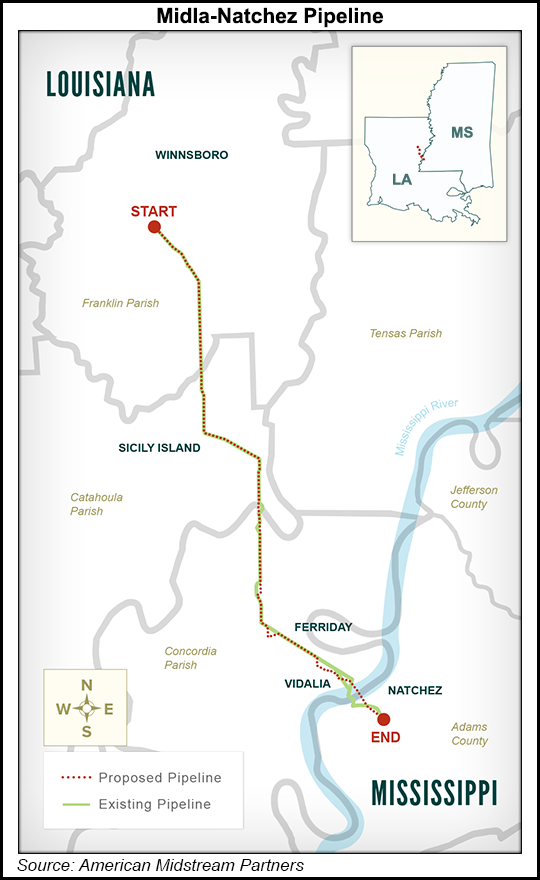Regulatory | Infrastructure | NGI All News Access | NGI The Weekly Gas Market Report
FERC Approves Natchez Pipeline, Which Will Replace Midla
FERC on Thursday granted American Midstream LLC authorization to construct and operate the Natchez Pipeline. It will replace the 89-year-old Midla pipeline system in Louisiana and Mississippi.

The project [CP15-523] calls for construction of a 51.96-mile, 12-inch diameter pipeline that would originate near Winnsboro, in Franklin Parish, LA. The pipeline will then traverse Franklin, Catahoula and Concordia parishes in Louisiana, cross under the Mississippi River and terminate in Adams County, MS, near Natchez. American Midstream will also construct a 0.5-mile, four-inch diameter lateral in Concordia Parish, located near milepost 46.81 of the mainline, to serve the city of Vidalia, LA.
The Natchez Pipeline will have three anchor shippers: Atmos Energy Corp., which serves the cities of Ferriday, Gilbert and Wisner, LA, and the city of Natchez, MS; the Louisiana Municipal Gas Authority, serving the municipal gas systems of Clayton, Jonesville, Sicily Island and Vidalia, LA; and BASF Corp., which has an industrial facility near Vidalia.
American Midstream’s application before the Federal Energy Regulatory Commission was uncontested and follows a settlement [RP14-638] announced one year ago and approved in April (see Daily GPI, Dec. 15, 2014). An environmental assessment was completed in November (see Daily GPI, Oct. 12).
Under the settlement, FERC agreed to allow American Midstream to abandon the Midla system, which includes about 370 miles of varying diameter pipeline and associated laterals from the Desiard Compressor Station in Ouachita Parish, LA, to a point near Scottlandville in East Baton Rouge Parish, LA. Meanwhile, the company agreed to continue to serve customers with delivery points from Winnsboro to Natchez through the new Natchez Pipeline. Once the new pipeline is complete, American Midstream will be able to abandon the Midla system, FERC said.
American Midstream officials could not be reached for comment Thursday. According to FERC documents, the company requested a certificate of public convenience and necessity by Dec. 31 in order for the new pipeline to be in service by November 2016.
Debate over the fate of the antiquated Midla system began in earnest in March 2014 after negotiations between American Midstream and its customers over repairs to the system foundered and there was no interest to an open season (see Daily GPI, March 13, 2014). The company subsequently began decommissioning Midla, triggering the wrath of several key lawmakers, including U.S. Rep. Bill Cassidy (R-Baton Rouge) and U.S. Sens. David Vitter (R-LA), and Mary Landrieu (D-LA), who chaired the Senate Committee on Energy and Natural Resources (see Daily GPI, April 11, 2014; April 7, 2014).
American Midstream filed an application with FERC to abandon the Midla system on March 28, 2014. Despite Landrieu’s calls for FERC to reject the company’s proposal, the regulatory agency agreed to its request for a rehearing for further consideration (see Daily GPI, Sept. 16, 2014).
ArcLight Capital Partners, a Boston-based hedge fund that owns American Midstream, agreed to a preliminary deal to construct the pipeline in October 2014 (see Daily GPI, Oct. 8, 2014).
The 370-mile Midla system was built in 1926, traverses Louisiana and Mississippi, and was designed to move gas from the then-prolific Monroe Gas Field in Ouachita Parish, LA, to a Standard Oil (now ExxonMobil Corp.) refinery in Baton Rouge, LA. In the early to mid-1970s, the system carried up to 300 MMcf/d. The mainline consists of 16- to 22-inch diameter pipe.
© 2024 Natural Gas Intelligence. All rights reserved.
ISSN © 1532-1231 | ISSN © 2577-9877 | ISSN © 1532-1266 |
